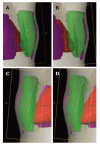Current role of modern radiotherapy techniques in the management of breast cancer
- PMID: 25114857
- PMCID: PMC4127613
- DOI: 10.5306/wjco.v5.i3.425
Current role of modern radiotherapy techniques in the management of breast cancer
Abstract
Breast cancer is the most common type of malignancy in females. Advances in systemic therapies and radiotherapy (RT) provided long survival rates in breast cancer patients. RT has a major role in the management of breast cancer. During the past 15 years several developments took place in the field of imaging and irradiation techniques, intensity modulated RT, hypofractionation and partial-breast irradiation. Currently, improvements in the RT technology allow us a subsequent decrease in the treatment-related complications such as fibrosis and long-term cardiac toxicity while improving the loco-regional control rates and cosmetic results. Thus, it is crucial that modern radiotherapy techniques should be carried out with maximum care and efficiency. Several randomized trials provided evidence for the feasibility of modern radiotherapy techniques in the management of breast cancer. However, the role of modern radiotherapy techniques in the management of breast cancer will continue to be defined by the mature results of randomized trials. Current review will provide an up-to-date evidence based data on the role of modern radiotherapy techniques in the management of breast cancer.
Keywords: Breast cancer; Hypofractionation; Intensity modulated radiotherapy; Partial breast irradiation; Radiotherapy.
Figures


Similar articles
-
Contemporary Breast Radiotherapy and Cardiac Toxicity.Semin Radiat Oncol. 2016 Jan;26(1):71-8. doi: 10.1016/j.semradonc.2015.09.003. Epub 2015 Sep 4. Semin Radiat Oncol. 2016. PMID: 26617212 Review.
-
[New tools in adjuvant breast cancer radiotherapy].Bull Cancer. 2007 Apr;94(4):389-97. Bull Cancer. 2007. PMID: 17449442 Review. French.
-
Left breast irradiation with tangential intensity modulated radiotherapy (t-IMRT) versus tangential volumetric modulated arc therapy (t-VMAT): trade-offs between secondary cancer induction risk and optimal target coverage.Radiat Oncol. 2019 Sep 2;14(1):156. doi: 10.1186/s13014-019-1363-4. Radiat Oncol. 2019. PMID: 31477165 Free PMC article.
-
Redefining radiotherapy for early-stage breast cancer with single dose ablative treatment: a study protocol.BMC Cancer. 2017 Mar 9;17(1):181. doi: 10.1186/s12885-017-3144-5. BMC Cancer. 2017. PMID: 28274211 Free PMC article. Clinical Trial.
-
Adoption of hypofractionated radiation therapy for breast cancer after publication of randomized trials.Int J Radiat Oncol Biol Phys. 2014 Dec 1;90(5):1001-9. doi: 10.1016/j.ijrobp.2014.09.032. Int J Radiat Oncol Biol Phys. 2014. PMID: 25539365
Cited by
-
Collective radioresistance of T47D breast carcinoma cells is mediated by a Syncytin-1 homologous protein.PLoS One. 2019 Jan 30;14(1):e0206713. doi: 10.1371/journal.pone.0206713. eCollection 2019. PLoS One. 2019. PMID: 30699112 Free PMC article.
-
Comparison of long-term outcomes between radical esophagectomy and definitive chemoradiotherapy in patients with clinical T1bN0M0 esophageal squamous cell carcinoma.J Thorac Dis. 2019 Nov;11(11):4654-4662. doi: 10.21037/jtd.2019.10.31. J Thorac Dis. 2019. PMID: 31903254 Free PMC article.
-
Radiotherapy setup displacements in breast cancer patients: 3D surface imaging experience.Rep Pract Oncol Radiother. 2018 Jan-Feb;23(1):61-67. doi: 10.1016/j.rpor.2017.12.007. Epub 2018 Jan 16. Rep Pract Oncol Radiother. 2018. PMID: 29379398 Free PMC article.
-
Intensity-modulated radiation therapy for early-stage breast cancer: is it ready for prime time?Breast Cancer (Dove Med Press). 2017 Mar 20;9:177-183. doi: 10.2147/BCTT.S127583. eCollection 2017. Breast Cancer (Dove Med Press). 2017. PMID: 28360536 Free PMC article. Review.
-
The Future of Radioactive Medicine.Radiat Res. 2023 Jul 1;200(1):80-91. doi: 10.1667/RADE-23-00031.1. Radiat Res. 2023. PMID: 37141143 Free PMC article. Review.
References
-
- Clarke M, Collins R, Darby S, Davies C, Elphinstone P, Evans E, Godwin J, Gray R, Hicks C, James S, et al. Effects of radiotherapy and of differences in the extent of surgery for early breast cancer on local recurrence and 15-year survival: an overview of the randomised trials. Lancet. 2005;366:2087–2106. - PubMed
-
- Paszat LF, Vallis KA, Benk VM, Groome PA, Mackillop WJ, Wielgosz A. A population-based case-cohort study of the risk of myocardial infarction following radiation therapy for breast cancer. Radiother Oncol. 2007;82:294–300. - PubMed
-
- Ragaz J, Jackson SM, Le N, Plenderleith IH, Spinelli JJ, Basco VE, Wilson KS, Knowling MA, Coppin CM, Paradis M, et al. Adjuvant radiotherapy and chemotherapy in node-positive premenopausal women with breast cancer. N Engl J Med. 1997;337:956–962. - PubMed
-
- Overgaard M, Jensen MB, Overgaard J, Hansen PS, Rose C, Andersson M, Kamby C, Kjaer M, Gadeberg CC, Rasmussen BB, et al. Postoperative radiotherapy in high-risk postmenopausal breast-cancer patients given adjuvant tamoxifen: Danish Breast Cancer Cooperative Group DBCG 82c randomised trial. Lancet. 1999;353:1641–1648. - PubMed
-
- Muren LP, Maurstad G, Hafslund R, Anker G, Dahl O. Cardiac and pulmonary doses and complication probabilities in standard and conformal tangential irradiation in conservative management of breast cancer. Radiother Oncol. 2002;62:173–183. - PubMed
Publication types
LinkOut - more resources
Full Text Sources
Other Literature Sources
Miscellaneous

